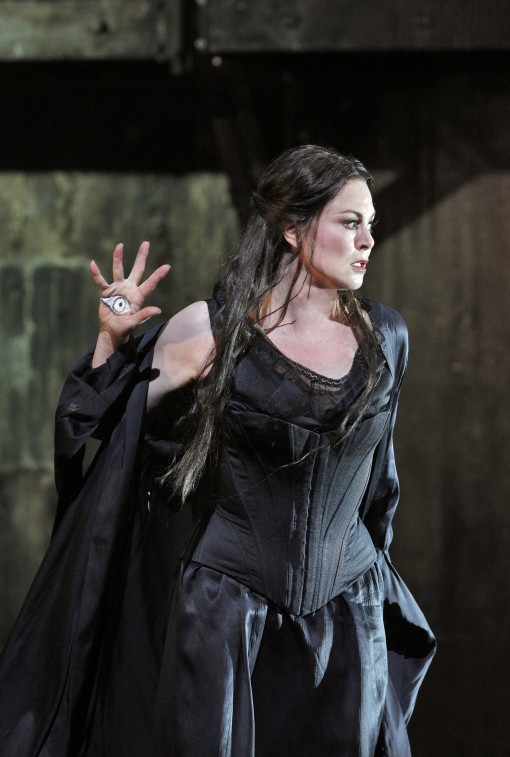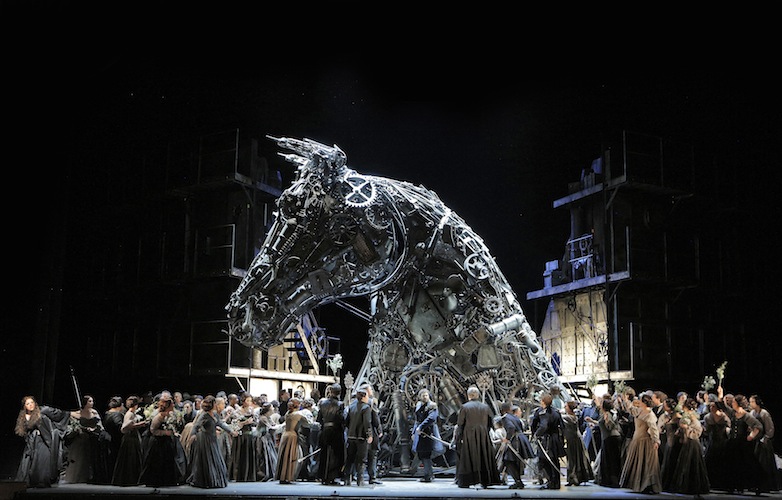A captivating Antonacci leads a strong cast in San Francisco Opera’s epic “Troyens”

Soprano Anna Caterina Antonacci is Cassandra in San Francisco Opera’s production of Berlioz’s “Les Troyens.” Photo: Cory Weaver
No sooner had the Trojans filled a mighty four-tier bleacher wall to celebrate the departure of the vanquished Greeks than Cassandra came along to spoil the fun.
From the first fateful lines she sang, in San Francisco Opera’s opening performance of Berlioz’ epic, rarely staged Les Troyens, it was clear that the night would be owned by soprano Anna Caterina Antonacci. Hair awry and one shoulder bared, she aimed her laser gaze and keening, dark-hued voice into the house, the prophetess issuing her dire warnings of death, destruction and the menace of that famous horse lurking just outside the city gates.
While Cassandra certainly wasn’t the only character or component of this production to captivate the audience – she’s gone by the second of five acts – her spirit hovered over the opera’s ominously clouded journey. Long after the action shifted to Carthage, where the Trojan hero Aeneas (the vibrant-voiced tenor Bryan Hymel) falls in love with Queen Dido (soprano Susan Graham, in magisterial form), Cassandra still seemed as present as ever.
Dido’s desperate fifth-act decision to die, played by Graham with gut-punching, raw emotion in front of a drop curtain on the lip of the stage, was infused with Cassandra-like bluntness. So, in a sense, was Aeneas’ feverishly sung impulse to leave Carthage and Dido behind, as if he were driven by a power beyond his control.
Berlioz spent 22 years on the work, creating an opera that has posed its own bedevilments for producers. But it’s not only the five-hour running time or the enormous artistic and technical resources required to pull it off that give Les Troyens its outsized sense of scale. A company must rise to the artistic scope of the undertaking.
In its first Troyens in 47 years, San Francisco Opera largely succeeded, with a strong cast in a vitally played and often gripping performance. They pulled out all the theatrical stops to do it, with 134 onstage performers and 95 musicians in the pit and backstage. Some sinuous and sexy ballet, in the luscious fourth act divertissements originally choreographed by Lynne Page, supplied added value, even if a distracted Dido waved them off.
The composer’s own libretto, based on Virgil’s Aeneid, has enough material to fill at least two operas. The pull of history sweeps men and women, warriors and wives and ordinary soldiers alike into its grip. Everything, including a Trojan Horse so large that only its scarily nodding head and neck came into view on the War Memorial Opera House stage, is writ large.
David McVicar’s physical production, first mounted in 2012 at Covent Garden and subsequently revived at La Scala before its current United States premiere here, was full of emphatic Big Statements. The scenes in Troy took place against a towering convex facade. Those in Carthage played out inside a sunset-orange concave, with Northern African detail and a large-scale model of Carthage that created some odd traffic patterns. Both settlings were opened out and deconstructed in various ways.
The 19th-century costumes (by Moritz Junge) and a Trojan horse that appeared to be fashioned out of giant Erector Set parts, suggested the world-changing transformations of the Industrial Revolution. An aerial-view disc of Carthage that rose like an eerie Google Earth vision at one point, offered another temporal dislocation.
To make it all work as music drama, whatever the time and place, Berlioz’ score carefully tracks and amplifies the action. Stirringly performed under returning hero Donald Runnicles, San Francisco Opera’s former music director, the music surged along with narrative drive, measured balance with the soloists and a large chorus and a prismatic range of keenly colored effects. Brass fanfares and ecstatic harps took their turn with mourning clarinets and pensive oboes.
This Les Troyens is seriously Cassandra-haunted. Antonacci (who alternates with Michaela Martens in the role) made sure that came across.
With the fine, richly conceived performances by Antonacci, Graham and Hymel leading the way, the other principals more than held their own. Mezzo Sasha Cooke sang the part of Dido’s sister, Anna, with amber-hued empathy. Baritone Brian Mulligan was a little undercharged as Cassandra’s fiancé, Coroebus, but then he was up against a powerhouse rival. Bass baritone Christian Van Horn was Dido’s firm-voiced, honorable counselor Narbal.
The San Francisco Opera Chorus, heavily employed here as both Trojan and Carthaginian witnesses to great events, brought their customary skill, urgency and majesty to the cause. Of all the memorable moments in Les Troyens, none was more potent than the chilling moment in which Cassandra has a stageful of women ready to commit suicide rather than submit to the Greek marauders hidden inside the horse. Their hands upthrust in unison, they were as transfixed by Antonacci’s magnetic prophetess of doom as the audience.
Les Troyens continues through July 1. sfopera.com; 415-864-3330.


Posted Jul 02, 2015 at 10:59 pm by Rich Persoff
Les Troyens shows us that Berlioz’ is unsurpassed in projecting emotions musically! But though the music was superb, the static production could have been much more engaging,. IMHO it suffered because so many opportunities to “show” the story, rather than tell it, were missed. Some examples:
+ The Horse could have been seen — outside the city — much earlier,where the non-discovery of its import would have made Cassandra’s rejected warnings all the more poignant.
+ Laocoon could have been seen to strike the horse, and be devoured by the sea-serpents — much stronger than reportage.
+The Greeks could have been seen exiting the Horse, the gates having been opened, and slaughtering the citizens inside the city. This would have directly motivated Cassndra’s mass suicide.
+Think of the movement with which Shakespeare would have handled the fighting between the Greeks and Trojans.
+The city should have been in flames, not the Horse.
+ The stage at too many times was cluttered with people who were not doing anything. This dilutes the impact of the principals.
All in all, an evening not to have been missed!